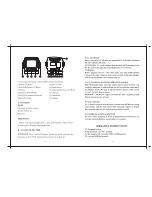
TP-6591 10/13
35
Section 3 Scheduled Maintenance
Problem/Condition
Means of Identification
Possible Cause/Solution
Gap-bridged spark plug
Built-up deposits and gap between
electrodes closing.
Oil or carbon fouling. Clean and regap
the spark plug.
Oil-fouled spark plug
Wet, black deposits on the insulator
shell, bore, and electrodes.
Excessive oil entering combustion
chamber through worn rings and
pistons, excessive clearance between
valve guides and stems, or worn or
loose bearings. Replace the spark plug.
Carbon-fouled spark plug
Black, dry, fluffy carbon deposits on
insulator tips, exposed shell surfaces
and electrodes.
Incorrect spark plug, weak ignition,
clogged air intake, defective fuel pump,
overrich fuel mixture, or excessive
no-load operation. Clean and regap the
spark plug.
Lead-fouled spark plug
Dark gray, black, yellow, or tan deposits;
or a glazed coating on the insulator tip.
Caused by highly leaded fuel. Replace
the spark plug.
Preignition damaged spark plug
Melted electrodes and possibly blistered
insulator. Metallic deposits on insulator
suggest internal engine damage.
Wrong type of fuel, incorrect timing or
advance, too hot a plug, burned valves,
or engine overheating. Replace the
spark plug.
Overheated spark plug
White or light gray insulator with small
black or gray/brown spots with bluish
(burned) appearance on electrodes.
Engine overheating, wrong type of fuel,
loose spark plugs, too hot a plug, low
fuel pump pressure or incorrect ignition
timing. Replace the spark plug.
Worn spark plug
Severely eroded or worn electrodes.
Caused by normal wear and failure to
replace spark plug at prescribed
interval. Replace the spark plug.
Figure 3-17
Engine Evaluation Using Spark Plug Condition
5. Clean spark plugs by wiping them with a rag. File
the center electrode to keep it parallel to the side
electrode.
Note:
Do not sandblast, wire brush, scrape, or
otherwise service spark plug in poor
condition.
Obtain a new plug for best
results.
6. Check the spark plug gap before installing any
spark plug. See Figure 3-18. Attain a correct gap
when the feeler (or wire) passes between the spark
plug electrode. It should pass easily but with some
resistance or drag; otherwise adjust as necessary.
The correct gap is 0.76 mm (0.030 in.).
1-514
1
2
1. 0.76 mm (0.030 in.) gap
2. Spark plug electrodes
Figure 3-18
Spark Plug Gap Inspection
7. Use a gapping tool to gently bend the side
electrode closer to or farther from the center
electrode to set the correct gap. See Figure 3-19.
Position the side electrode directly over the center
electrode.
Содержание 10EKD-Low CO
Страница 4: ...TP 6591 10 13 4 Notes...
Страница 8: ...TP 6591 10 13 8 Safety Precautions and Instructions Notes...
Страница 12: ...TP 6591 10 13 12 Section 1 Service Views Notes...
Страница 42: ...TP 6591 10 13 42 Section 5 Wiring Diagrams GM90655A Figure 5 1 Point to Point Wiring Diagram Sheet 1 of 2...
Страница 43: ...TP 6591 10 13 43 Section 5 Wiring Diagrams GM90655B Figure 5 2 Point to Point Wiring Diagram Sheet 2 of 2...
Страница 44: ...TP 6591 10 13 44 Section 5 Wiring Diagrams ADV8631A Figure 5 3 Schematic Wiring Diagram Sheet 1 of 1...
Страница 48: ...TP 6591 10 13 48 Notes...
Страница 49: ...TP 6591 10 13 49 Notes...
Страница 50: ...TP 6591 10 13 50 Notes...
Страница 51: ...TP 6591 10 13 51 Notes...
















































